TURKISH BALLERINAS
By Louise Lamarche Cozy slippers knitted flat and in the round.
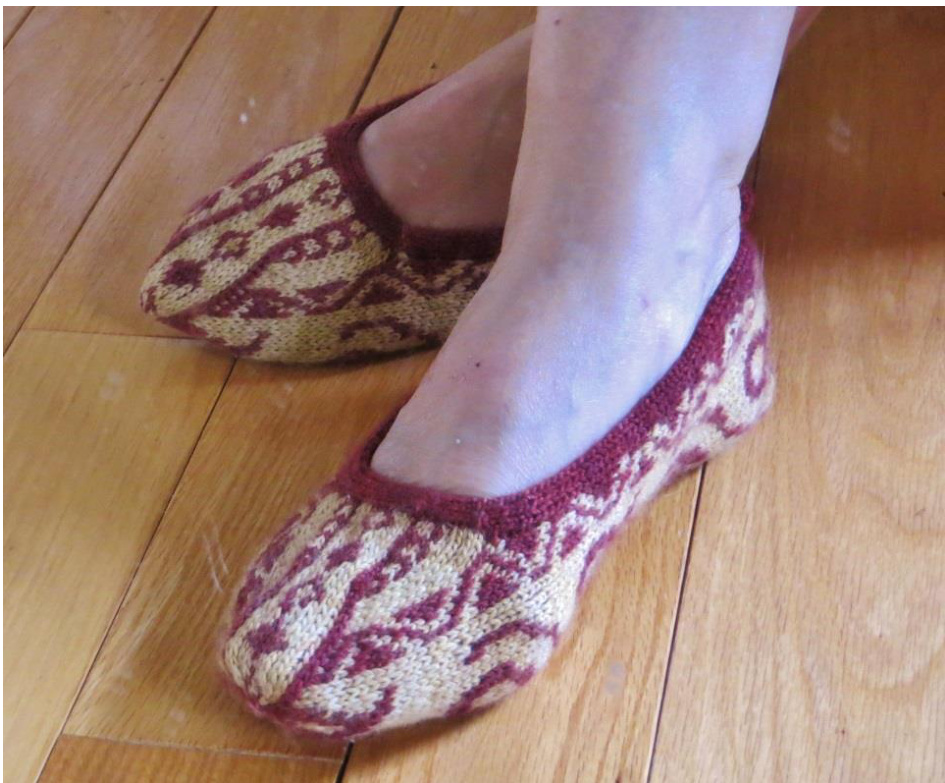
The I-cord trim is knitted as you go along and becomes an elastic casing - no finishing required. With this technique, these ballerinas stay on the foot and you do not need to fiddle with accurate measurements. The fairisle makes them interesting to knit and adds warmth, cushiness and comfort. Sizes: 5/6 (7/8, 9/10)
Yarn & Notion Requirements
60 g sock yarn - 30 g of each color - these were knitted in Biscotte Felix (115 g - 384m, 420 yds) 2.75mm DPNs and 2.75 circular needle Markers Round-end needle for grafting and inserting elastic Sewing needle and thread for securing both ends of elastic 60 cm elastic - 4mm wide
Applied techniques:
Judy's Magic Cast-on - video link https:/ /www.youtube.com/watch?v=19jVjlay5Lk I-cord flat and along border - step by step instructions Intarsia and fairisle knitting - tips on crossing threads on last page video link intarsia:http: / /www.youtube.com/watch?v=MAi8og9sA_W video link fairisle: http:/ /www.youtube.com/watch?v=dtDGR2NM9-Q Kitchener grafting - step by step instructions and video link grafting: http://www.bing.com/videos/search?q=how+to+do+the+kitchener+stitch+video&FORM=VIRE3#view=detail&mid=0504 0719408938E4753705040719408938E47537
HEEL TAB
If you are not familiar with Judy's Magic Cast on please look at the following video but use twoDPNs: https:/ /www.youtube.com/watch?v=19jVjlay5 Lk Using the Judy's Magic Cast-on method and two 2.75mm DPNs and the trim color, do a double needle provisional cast-on of 6 stitches on each needle. With a third DPN, knit the 6 stitches of the top needle once. Put the 6 stitches of the bottom needle on a stitch holder or plastic safety pin.
I-cord tab border:
1. Slide the 6 stitches from the top needle to the RH side (the yarn will be on the LH side). Begin knitting the 1stitch by pulling the yarn tightly over from the last stitch. Knit the remaining 5 stitches. Slide the 6 stitches to the opposite end of the DPN (the yarn will be attached to the last stitch instead of the first, as usual) 2. Once you have knitted the last stitch, (stitch 6), slide your work to the opposite end of the DPN, Knit the 1st stitch again very tightly, grabbing the yarn from the last stitch (the knitting will roll up, that's how it becomes an cord) While you are working the I-cord you are NEVER turning your work over, you are just sliding your 6 stitches back and forth (left and right) on your DPN. Repeat the process 10 more times for a total of 12 Rows You now have 6 stitches on the holder at the bottom of the I-cord, and 6 stitches on the DPN at the top of the I-cord.
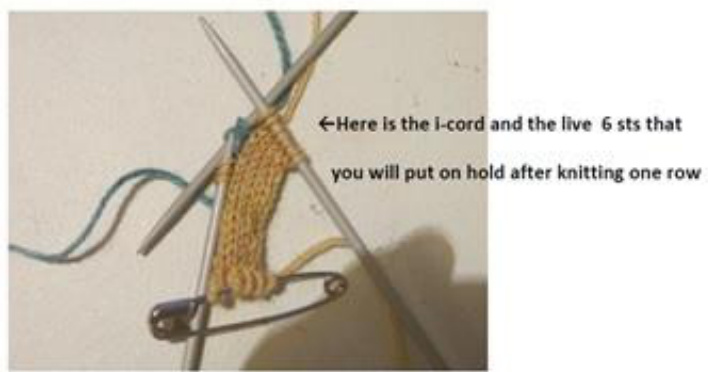
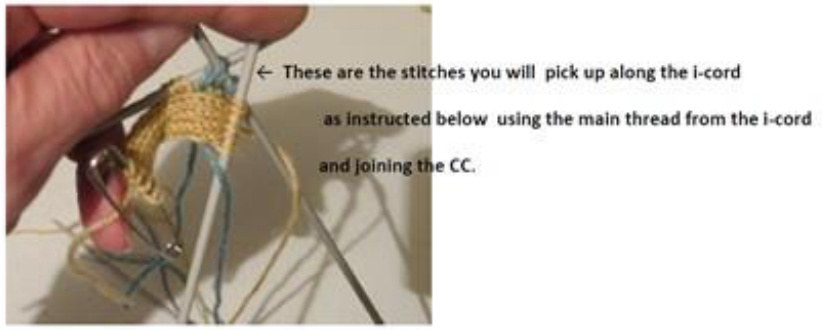
Turn your work sideways so that the stitches on the holder are on your LH side and the stitches on the DPN on the RH side.
Notes:
If you flatten the I-cord, it will be easy to see the straight columns of stitches from which you will pick up single back loops. After row 1, put the 6 stitches from the I-cord on a stitch holder or safety pin, (see photo) As this becomes intarsia knitting, to avoid gaps make sure you follow the tips on crossing your yarns explained on last page. Picking up stitches and knitting the heel tab Starting on the RH side, using a DPN, pick up 11 stitches and knit as follows:
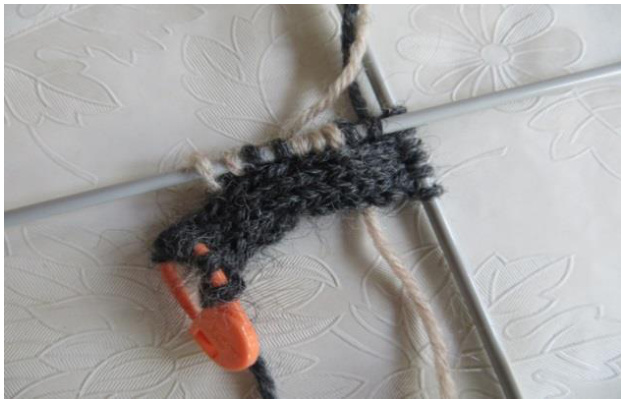
ROW 1 (RS): Knit first 2 stitches in CC (this will be the I-cord). Knit the following 7 stitches in heel tab pattern. Knit last 2 stitches in CC (l-cord on the opposite side) ROW 2 (WS): purl F/B, P1 in CC (for a total of 3 stitches in CC). Purl 7 in Heel Tab pattern. Slip remaining 2 stitches onto R/H needle. Turn work to RS. In CC, pull tightly, knit F/B, K1 in CC (for a total of 3 stitches in CC). Slip knitted stitches back onto LEFT needle. You now have 13 stitches. ROW 3 (RS): Cross colours, pull tightly, (lcord) knit first 3 stitches, k7 in heel tab pattern, slip remaining 3 stitches onto RH needle, turn work. Purl the 3 sts, then place purled stitches back onto LH needle. ROW 4 (Ws): Turn work, cross colours, pull tightly, (l-cord) purl first 3 stitches, P7 in heel tab pattern. Slip remaining 3 stitches onto RH needles, turn work. Knit the 3 stitches of the I-cord. Return stitches back on LH needle Repeat ROwS 3 and 4 until you have knitted the 24 rows of the heel tab pattern. Cut both yarns.
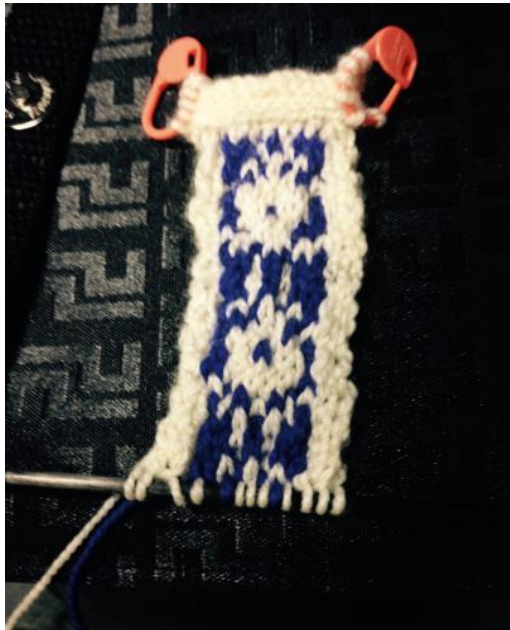
You have created an I-cord on each side of the heel tab from which you will be picking up stitches to make the sides of the slipper.
SLIPPER FOOT - This section is knitted back and forth.
With right side facing, slip the 6 I-cords stitches from holder to a DPN. Do not knit the first 5 stitches.
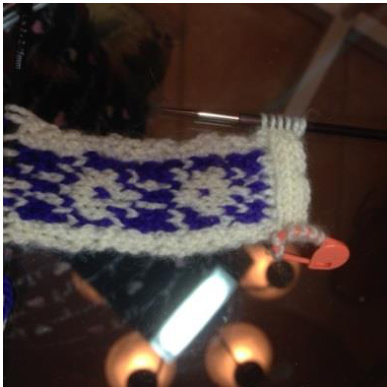
Attach yarns and keeping in pattern with both ColorS, KNIT FOOT CHART: ROW 1 (RS): with a DPN, knit the 6th stitch from the border I-cord with the first stitch you will pick up along the heel tab I-cord, pick up and knit another 22 stitches in foot chart pattern. Knit the first stitch from the bottom of the heel. Total count on the first DPN: 5 Icord and 24 sts in pattern. p.3 With another DPN, and continuing Row 1 of the FOOT CHART, knit the stitches from the bottom of the heel tab - proceed as follows for this row only: K2 tog, K7, K2 tog - Keep last stich for the third DPN. Total count on the second DPN: 9 sts in pattern. With another DPN and continuing Row 1 of the FOOT CHART, knit last stitch of the bottom of heel tab, pick up and knit 23 stitches along heel tab I-cord. Knit the last picked up stitch together with the first stitch of the 6 st Icord. Slip the remaining 5 I-cords on the DPN - DO NOT KNIT. Turn work. Total count on the third DPN: 5 I-cord and 24 sts in pattern.
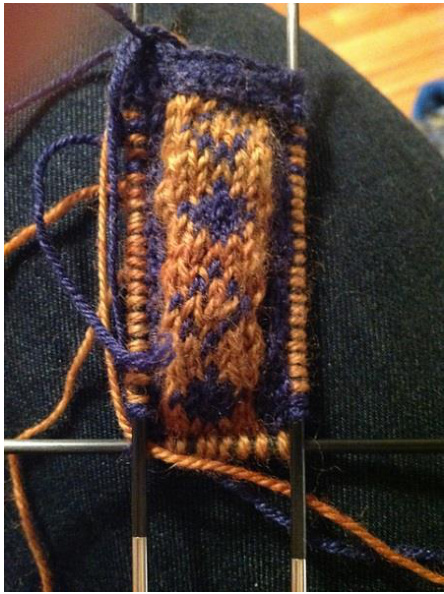
TOTAL NUMBER OF 67 STS. ROW 2 (WS): Cross colors, pull tightly and P5 (l-cord) - purl 57 sts of foot chart pattern. Slip remaining 5 sts onto RH needle, turn work. Cross colors, pull tightly and K5 (lcord). This represents the end of the row. Place the last 5 sts back onto LH needle.
TOP OF THE FOOTI-CORDBORDER&CASING
ROW 3 (RS): Cross colors, pull tightly and K5 (l-cord) - knit 57 sts of foot chart pattern. Slip remaining 5 sts onto RH needle, turn work. Cross colors, pull tightly and P5 (lcord). This is now the end of the 3rd row. Place the last 5 sts back onto LH needle. Note: after 4 or 5 rows, sew in tails so they are not in the way, closing gaps if any, however, be careful not to close the I-cord Continue FOOT CHART repeating the I-cord process as per rows 2 and 3. Change to 2.75mm circular needle as soon as you can and knit back and forth with the magic loop method; after about 20 rows you won't need the magic loop. On the right side of work, slip the 5 I-cord stitches on a DPN and knit the I-cord in the same manner as the I-cord heel tab border. Increase the I-cord from 5 to 6 sts as such: K4 - K1 front and back. Knit 22 (24, 26) I-cord rows. Note: You may continue to knit with the DPNs instead of changing to the magic loop. It is a matter of preference. Repeat the 36 rows as needed until you reach 15 (16, 17) cm ending on a wrong side. Do not cut yarns. This will eventually become the start of ROw 1 of the TOP OF FOOT chart. Cut yarn and leave a 20 cm tail for grafting. Leave sts on DPN. Cut elastic 27 (29, 31) cm. Thread the elastic on the large round end needle and insert in casing. Sew both ends of elastic together. Slide the other 5 sts I-cord to aDPN. p.4 Bring both DPNs facing one another with the yarn tail coming from the back right side. Insert thread in grafting needle. You may wish to view this video on grating - however please follow step 2 of my instructions as the number of stitches is not even on both needles. http://www.bing.com/videos/search?q=how+to+do+th e+kitchener+stitch+video&FORM=VIRE3#view=detail& mid=05040719408938E4753705040719408938E47537
Grafting:
1. Insert grafting needle purlwise in first stitch of front needle. Leave on needle. 2. Insert grafting needle knitwise in the first 2 stitches of back needle. Leave on needle. NOTE: (you insert the needle into two stitches only this one time, after this one time you will insert the needle ALWAYS into ONE STICH ONLY) 3. Insert grafting needle knitwise in first stitch of front needle. Slide off. Insert grafting needle purlwise in next stitch of front needle. 4. Insert grafting needle purlwise in first two stitches together of back needle. Slide off (see above note.) Insert grafting needle knitwise in next stitch of back needle. Stitch count is now the same on both DPNs. 5. After the first graft you now have an EVEN number of stitches on both DPNs, 4 stitches. Repeat steps 3 and 4 ONE stitch at a time (See Note.) After removing the last stitch, you will have closed off the casing. Cross your work and stretch the elastic so that the elastic join does not make a bump at the grafting join.
TOE PORTION OF THEFOOT
To make up the toe portion of the foot, reattach CC yarn where you left off the MC yarn, place a marker to indicate the beginning of the round and knit row 1 of the CLOSED FOOT CHART . When you reach the top border, pick up and knit 21 (23, 25) stitches along the I-cord as per chart. Total of 78 (80, 82) sts. YOU WILL NOW KNIT IN THE ROUND. To avoid gaps on each side of the top of the foot, I suggest that you divide your work in two after the first 7 stitches following the marker - there will be 39 (40, 41) sts oneachneedle At ROW 12 of CLOSED FOOT CHART,INSERT MARKERSASFOLLOWS: Start your count at the beginning of the round marker, that is AFTER the LAST stitch of the Top of the Foot Chart pattern: 1. Count 25 stitches, Place Marker (PM) 2. Count 7 stitches, PM 3. Count 31 (32, 33) stitches, PM 4. Count 9 stitches, PM Start decreases on next row as follows: \* Knit to two stitches before marker, K2tog in CC. Knit to next marker, slip marker, SSK in CC. \* Repeat \* \*. WATCHTHATYOUFOLLOWTHEPATTERN DESIGN AS YOU DECREASE. To make this easier, use a working chart and mark with an X the SSK decreased stitch. This will help you keep track of the design and it will be a good reference for the second slipper. Eventually your last decrease will include stitches from the next round. At some point, you will need to re-arrange stitches on the needle tips to facilitate the decreases. Decrease until you have 9 sts on bottom and 11 sts on top. Cut both threads and pass through all stitches twice. Here is another good video that demonstrates how: http://www.bing.com/videos/search?q=how+to+finish+ off+a+knitted+hat&FORM=VIRE9#view=detail&mid=1C0 335FBF3721D6A2F261C0335FBF3721D6A2F26
LOOP ON TOP OFHEEL TAB
With DPN, pick up and knit 8 stitches in CC along the top I-cord of the heel tab. Knit an 8 st I-cord for 15 rows. Cut 20 cm thread. Fold in half and sew each stitch to the pick-up row.
TIPS ON CROSSING YARNS FOR INTARSIA:
Do not make a full wrap around the yarn as it will be hard to pull and close gap. On the purl side bring the background thread from under away from you and pass it over the border thread. Continue knitting the I-cord with the border thread. When you repeat the operation on the second round, both threads will be crossed and there won't be a gap as you continue knitting the rest of work if you pull tightly on the background thread. On the knit side bring the background thread towards you and pass it over the border thread. Continue knitting the I-cord with main thread. When you repeat the operation on the second round, both threads will be Crossed and there won't be a gap as you continue knitting the rest of work if you pull tightly on the background thread. Videos are rare on intarsia border. I have found this one that is very good. Keep in mind that you are not doing the same type of border but the method of crossing is good. http://www.youtube.com/watch?v=MAi8og9sA_w
TIPS ON CROSSING YARNS FOR FAIRISLE
Fairisle is preferably done with a color held in each hand. The contrast yarn (motif) should come from below to stand out more - yarn held in left hand. If you are not familiar with carrying floats, please look at this video to the end. It is excellent; very clear explanation from Lori1551. http://www.youtube.com/watch?v=dtDGR2NM9-Q.

If you have any questions, please do not hesitate to contact me at:
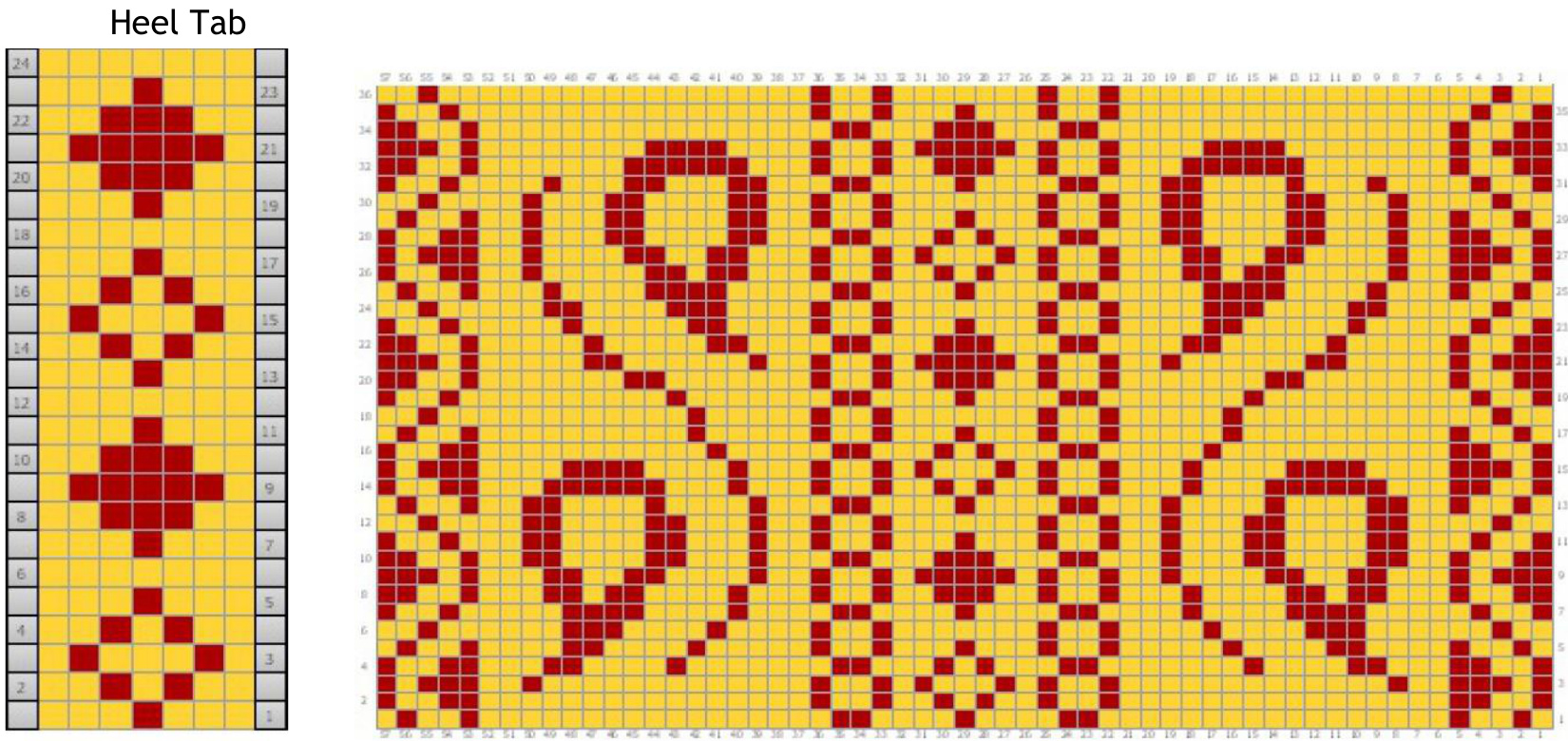
Foot Chart
CLOSED FOOT CHART (TOE PORTION) use FOOT CHART then add TOP OF TOE CHART
Top of toe Chart
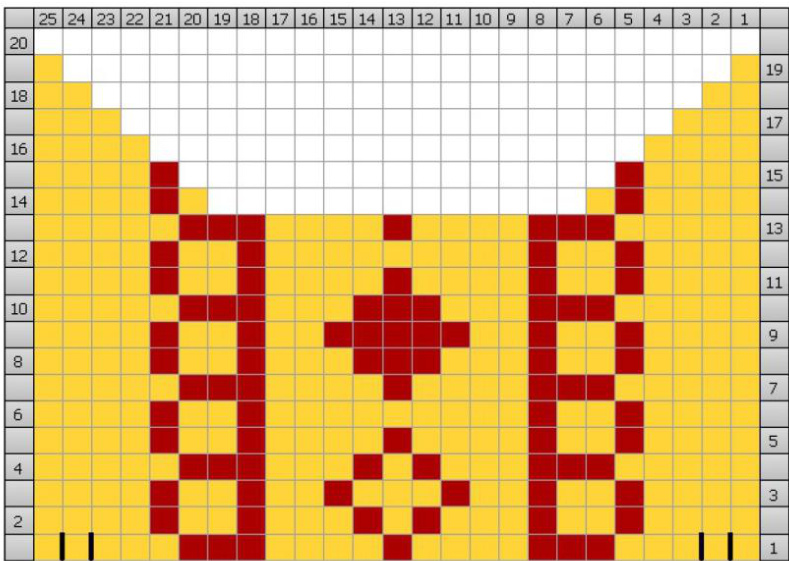
Size 5-6 columns 3 to 23 Size 7-8 columns 2 to 24 Size 9-10 columns 1 to 25









